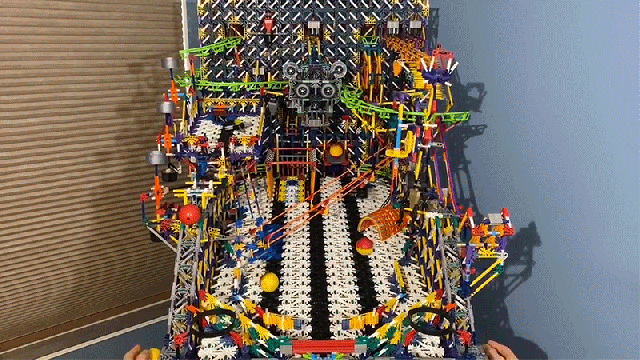K’Nex has been around for less than 30 years but has already become the building toy of choice for elaborate creations that are impossible to build with Lego. Tyler Bower just demonstrated the potential with a 2.29 m-tall functional pinball machine that even keeps score.
The paddles that send balls careening across the table appear to be manually powered mechanisms, as does the launcher that that starts a new game. But hidden deep in the bowels of the 1.52 m-long machine are three motors, including a high-torque motor from an electric drill, that power 10 chain lifts delivering balls to various parts of the game.
There are no flashing lights, so this K’Nex pinball machine isn’t a sensory assault on the eyes like most are, but it still manages to include challenging obstacles and targets for scoring points, including spinners, trapdoors, and moving ramps leading to a handful of elevated tracks and gravity-powered animated features.
A connected laptop running custom Scratch code keeps tabs on scores and the player’s ball count, and a screen that sits on the table’s backbox gives real-time feedback. To keep the pinball machine as pure as possible, a Makey Makey circuit board is used to track scoring as well as the location of the balls in play. As the balls roll across the table and throughout the machine’s internals they press on levers and buttons wrapped in aluminium foil to complete simple circuits that the Makey Makey detects as button presses. The custom code powering the pinball machine then decodes these button presses to tally points or end the game when all three balls have fallen out of play. It seems simple, but crack open a real pinball machine and you’ll probably find a lot of similarities, like the use of simple electrical circuits that the metal ball completes as it rolls around the table’s surface.
The one thing that’s missing? A tilt sensor. As you can occasionally see demonstrated throughout the video, K’Nex isn’t known for its structural stability. The pinball machine shakes and wiggles like a giant bowl of Jell-O as it’s being played, which would trigger a tilt sensor the moment a player started activating the paddles. It might be a compromise in authenticity, but at the same time, the unwanted motions add another element of challenge to the game.
